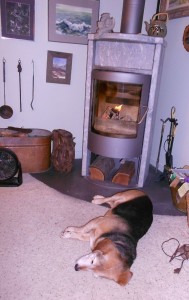Explaining making cases seems to be taking even longer than actually making them! We’re getting close to the end. Promise! This blog will be a quickie, just on covering the boards. It’s one of my favorite parts as it is really the beginning of the end and I wind up with something that really looks like a book. It also is the stage where my decisions on color, size and paper either come together or just miss.
So here are the graphics:
-

-
Trimmed cover, right side
-

-
Trimmed cover, pasted out
-

-
Cover paper pasted on front, ready for edges to be turned in
-

-
Head and Tail pasted down
-

-
Fore edge pasted
-

-
Cut covers and boards with spine
-

-
Positioning decorative paper cover
-

-
Trimming corners
-

-
Matching up cover paper
-

-
Folding down corners to be trimmed
-

-
Pasting down cover
-

-
Half-cloth waiting for corners
-

-
Corners aligned with grain of spine
-

-
Pasting down corners front
-

-
Corner trimmed and pasted
-

-
Corners finished
-

-
Covers stacked with wax paper
-

-
Covers under weight until dry
-

-
Finished covers
First the cover paper is cut to size leaving about 3/4″ turn-in on three sides. Fourth side will be flush with the spine. Before pasting out the paper, measure the paper against the spine and put a tiny pencil mark at head and tail. These will be your guides as you place the paper down. Using these marks as guides, place the dry paper under the board and trim the corners. I use two pieces of scrap board as a cutting guide. This gives a turn-in on the corner that is a bit larger than recommended, but it has saved a lot of covers for me!
With everything marked and trimmed, paste out the paper starting from the center. Always put your adhesive on the paper and not the board. Paper stretches when it comes in contact with any moisture and you want it to stretch before it is on the board. This way, as the paper dries, it will shrink giving a nice smooth fit. Paper that has been pasted out will tend to curl or become all loose and floppy so the register marks become very important. As you place the paper down, the marks will NOT be quite accurate because of the stretching. If you are worried about getting a perfect edge between the paper and spine, you can let the paper ride up over the spine by a tiny amount, not more than 1/32 inch.
When I paste out, I leave a very small dry area at the fore edge turn-in and on the spine edge of the head and tail turn-ins. This allows me to handle the paper from these very small dry areas and not get PVA all over my fingers. It also seems to give me more control over the paper. The bad part of this is that some papers will pucker around any dry area. As with any technique, try several and use the one that works for you. I work with many different weight papers for my covers and have found that I have to adapt my techniques to the paper.
Lay the paper down, starting at the spine edge and gently smooth it down toward the edges. Don’t rub it down hard until you are sure that it is smooth and positioned correctly. Make a fist and use the pinkie side to smooth down the paper. This is the flattest surface you can make with your hands. Bone folders are not recommended in smoothing damp paper. It’s just too easy to press too hard and tear the paper. I do use them or the back of a fingernail on the edges on the board to get a nice crisp edge. After the front is pasted, flip the board over and turn in the head and tail and finally the fore edge margins. You may have to add paste if it has dried or if you have used my “dry spot” method. Cover the back board in the same way and you are done! Ideally you should have a 3/4″ turn-in all around the case.
Notes on special cases: If your cover paper has a figurative design, you’ll want to take care on the cover placement. See the airplane design in the photos. In cutting the paper, I had to waste a bit of paper to place the red plane where I wanted it. With any designs that have a definite up and down, make sure you cut pieces that are mirror images of each other, not the same and that both are facing in the same direction when on the book. All over designs are much easier.
Half-cloth binding: On the binding that has bookcloth on the corners, I marked the board with diagonal lines 1″ in from the top and bottom fore edges. After registering the head and tail, I folded the paper along those lines. The paper was then trimmed along the same lines and pasted down, leaving the board exposed in the corners. The small triangles of book cloth were pasted onto the board corners, trimmed, folded under and pasted down.
In general when pasting, always put the paste on the material that will stretch the most. Everything, even board and wood will stretch when wet. With some materials it is hardly noticeable. PVA dries faster than paste which has the advantage that it “grabs” quickly and the disadvantage that re-doing something becomes harder. Paste is much more forgiving and a cover can be repositioned several times, but it grabs more slowly and you may have to hold something in position for a while.
Next I will put the finishing touches on the textblock and marry the case to the text.
Like this:
Like Loading...



























































































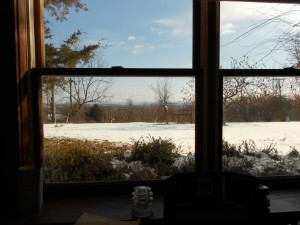






















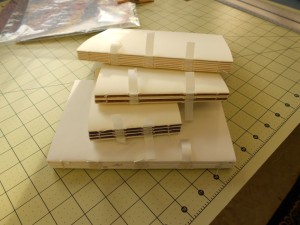 Next I tipped in the endpapers and trimmed them to size. An extra 1/4″ is left along the inside fore edge of both endpapers. This is folded under and glued to the first and last pages of the textblock.
Next I tipped in the endpapers and trimmed them to size. An extra 1/4″ is left along the inside fore edge of both endpapers. This is folded under and glued to the first and last pages of the textblock.




















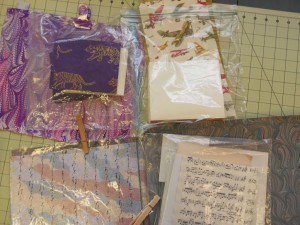
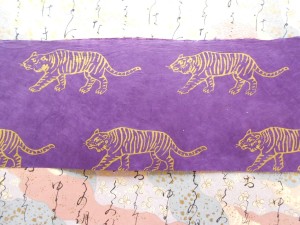 It’s a long, narrow piece and I was thinking about making a very small book with just one or two tigers on the cover. As soon as I started to think about size, I realized it would never work. Even a small book needs at least 1/2 inch turn-in on both top and bottom. This is what the cover would look like after a normal 3/4 inch turn-in.
It’s a long, narrow piece and I was thinking about making a very small book with just one or two tigers on the cover. As soon as I started to think about size, I realized it would never work. Even a small book needs at least 1/2 inch turn-in on both top and bottom. This is what the cover would look like after a normal 3/4 inch turn-in. 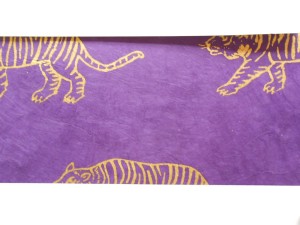 Not really what I wanted. I can use it for endpapers, so I revamped my thinking and started looking for paper to use as covers. I found a piece of my marbled paper that goes quite well with the purple, so even though it’s not at all what I’d planned, I’m happy with the combination.
Not really what I wanted. I can use it for endpapers, so I revamped my thinking and started looking for paper to use as covers. I found a piece of my marbled paper that goes quite well with the purple, so even though it’s not at all what I’d planned, I’m happy with the combination.












